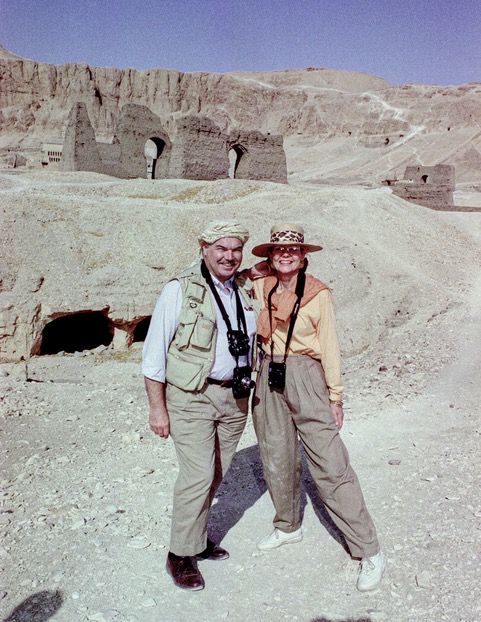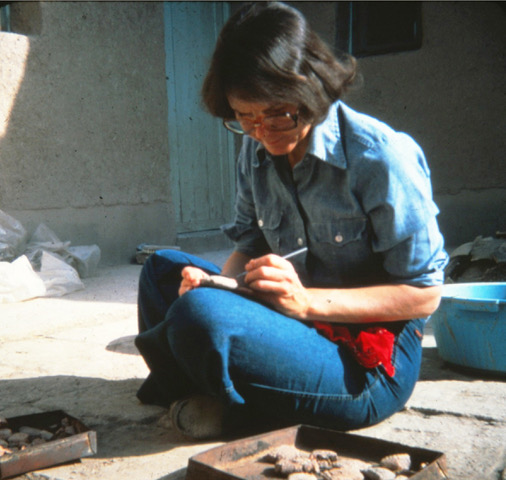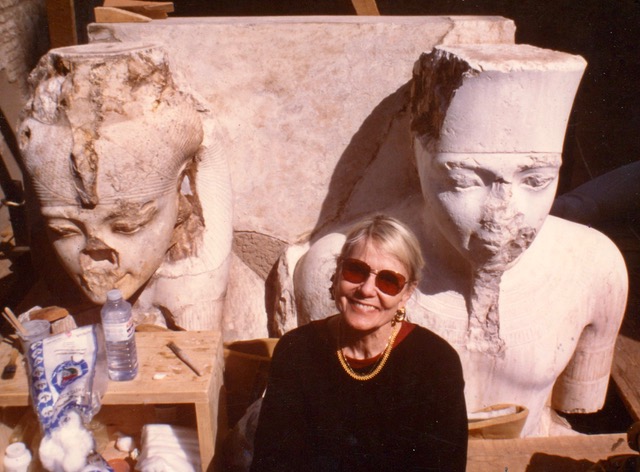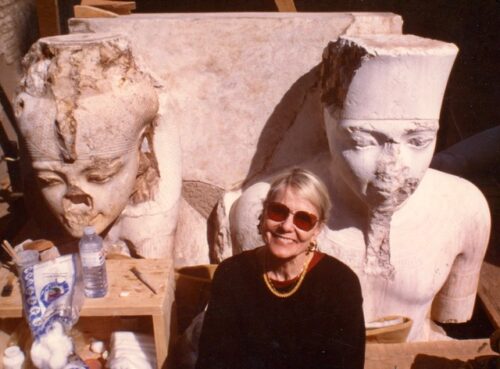By Carlotta Maher
 David and Carlotta Maher at Deir al-Bahri, mortuary tomb of Queen Hatshepsut, on the west bank of Luxor, circa 1984
David and Carlotta Maher at Deir al-Bahri, mortuary tomb of Queen Hatshepsut, on the west bank of Luxor, circa 1984
Editor’s Note: In excerpting a recently published recollection from the late Carlotta Maher’s “Morning of Goodness, Morning of Light, essays on her travels and work in the Middle East,” we reflect that goodness, light and the spirit of adventure came together in one package which was Carlotta Maher, known to so many as Chicago’s Queen of the Nile. In his forward, her husband David Maher, tells us more about what brought this magical woman to the Middle East, and her words follow in “My Room”. As we move boldly into 2023, may we all have a bit of Carlotta’s sense of adventure and desire to follow our passions.
Carlotta Maher’s career in the Middle East began by happy accident in the early 1970s, as a young mother of two, she visited the Oriental Institute at the University of Chicago, one of the world’s premier centers of Egyptology and Mesopotamian studies. She had been fascinated by ancient Egypt since childhood, and immediately volunteered to become a museum docent. Soon she was running the volunteer program and taking graduate classes in Egyptian hieroglyphs. In 1976, Professor McGuire Gibson invited Carlotta to join the Institute’s dig in Nippur, Iraq. She worked in Iraq for four seasons, 1976-1979. The Iraq-Iran war interrupted the Nippur expeditions, but a couple of years later, Carlotta was invited to join the Oriental Institute’s Epigraphic Survey at Chicago House in Luxor, Egypt. She spent 23 seasons in Luxor; generally, she would depart from Chicago in October and return in April. Her work was recognized by the Oriental Institute in 1997 when she was the recipient of the first James Henry Breasted Medallion for contributions to Near Eastern Archaeology.—By David Maher.
 Carlotta Maher, cataloging artifacts in Iraq, circa 1976.
Carlotta Maher, cataloging artifacts in Iraq, circa 1976.
MY ROOM
By Carlotta Maher
My room is in Luxor, Egypt. If one of the big crows outside my room flew three miles straight west it would land at the tomb of Tutankhamen. I first inhabited this room as a guest in 1983. It was April, and the dusty red floor tiles were intolerably hot on my bare feet. Temperatures were at least 102 degrees F. that week. The room was small; maybe ten feet by ten feet, but the walls were high, spotted with body parts of countless mosquitoes, squashed by previous guests.
Later this room has become mine. Living in it is an assault on the senses—noise here is life, so the more the better. Call to prayer, early and late, with each mosque striving for better amplification. Bus and car horns blat ceaselessly as tourists move about.
I am alarmed by crashes and male voices shouting before dawn from the kitchen below me—I find it is only exuberant greetings and blessings from the kitchen staff to each other as they fling pots around, preparing our breakfast. I give up trying to sleep and start preparing Nescafé with my immersion heater, my mug on the red floor tiles of my room. Then I step through my French door to the balcony to drink it by moonlight. When the sun finally rises, the endless flocks of birds will begin their songs. One who lives outside my room makes a noise exactly like a telephone ringing. Then the rustle of ancient flip-flops as the servants arrive…the snapping of ragged dust cloths against screen doors, clouds of dust arise and settle elsewhere, in the courtyard, the endless sweeping of fallen leaves and blossoms.
 At Luxor Temple, with goddess Mut and King Tutankhamen statues under restoration
At Luxor Temple, with goddess Mut and King Tutankhamen statues under restoration
From “Morning of Goodness, Morning of Light – Carlotta Maher’s Memories of the Near East” (Beekman Press, New York, 2022). Copies of “Morning of Goodness, Morning of Light” are available for donors to the Jill Carlotta Maher Youth & Family Program Endowment fund at the Oriental Institute. To make a donation and receive the book, please contact Bill Cosper, Director of Development, Oriental Institute, at bcosper@uchicago.edu.






